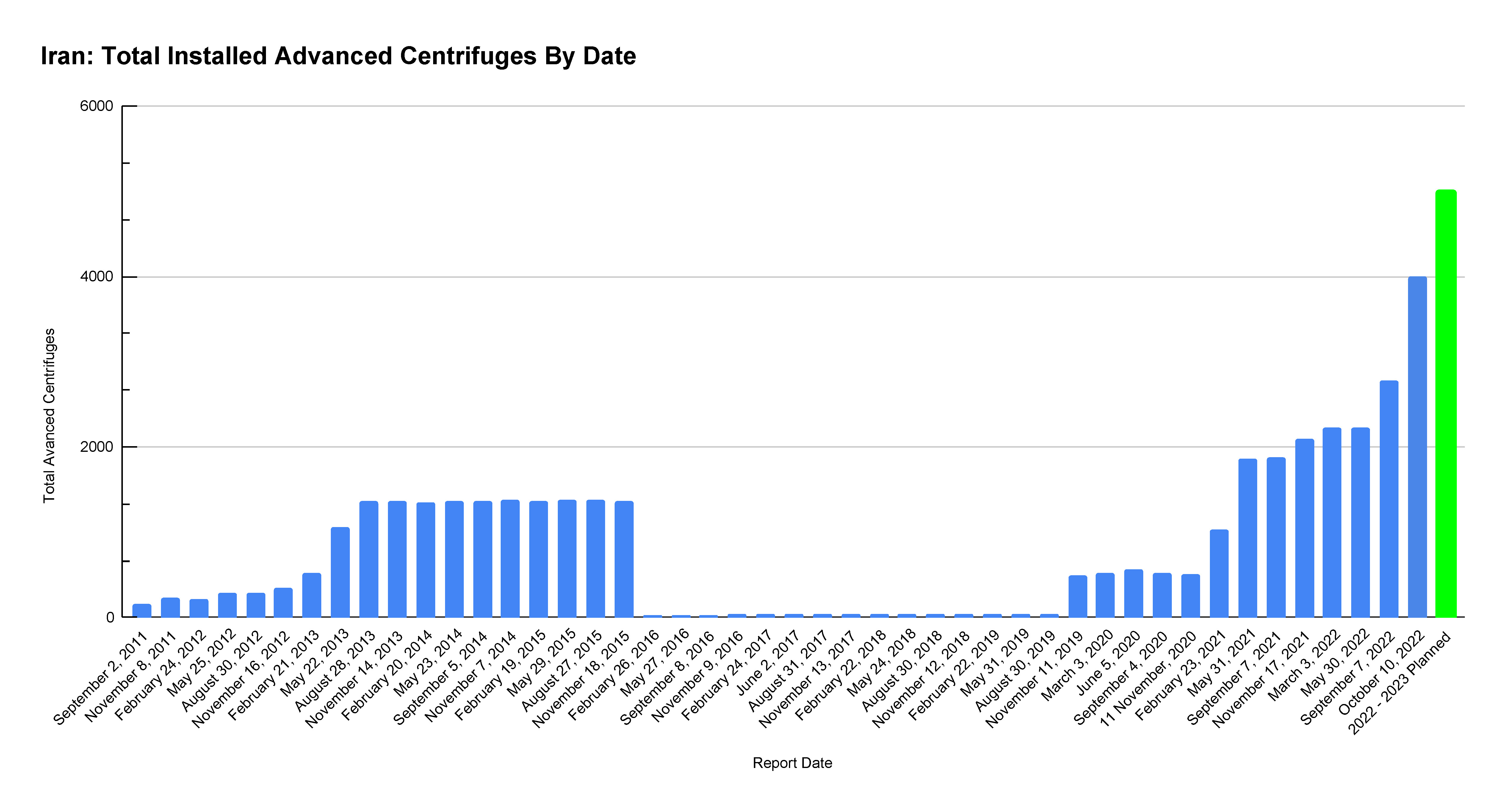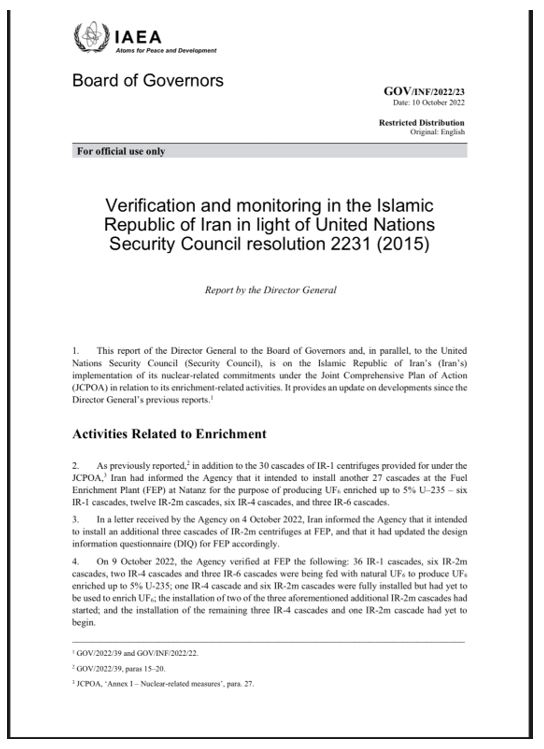Reports
Iran’s Vastly Increased Advanced Centrifuge Deployment at Natanz Underground Facility
by David Albright, Sarah Burkhard, and Spencer Faragasso
October 25, 2022
Background
- The International Atomic Energy Agency (IAEA) regularly issues reports tracking advancements in Iran’s nuclear program that further violate the Joint Comprehensive Plan of Action (JCPOA).
- The Institute analyzes these reports, in particular, the number and type of Iran’s advanced centrifuges in quarterly reports. The last one is here.1
- On October 10, 2022, the IAEA issued a new report on Iran’s advanced centrifuge deployments at the Natanz Fuel Enrichment Plant (FEP) (reprinted in the Annex).
Findings
- As of October 10, 2022, Iran had 4000 advanced centrifuges installed across all three of its declared enrichment facilities, representing an increase of 44 percent from the 2782 that were installed as of late August 2022. The new deployments include six new IR-2m centrifuge cascades and one new IR-4 centrifuge cascade at the Natanz Fuel Enrichment Plant (FEP), where each cascade typically includes about 174 centrifuges.
- The recent expansion, which is continuing, involved quickly doubling the number of IR-2m centrifuges at the FEP. Iran also announced its intention to add three additional IR-2m cascades there, two of which were being installed. When finished, Iran will have 15 IR-2m cascades at the FEP.
- Iran finished installing one IR-4 cascade at the Natanz FEP, bringing the total number of installed IR-4 cascades at the FEP to three. Iran is halfway towards its goal of six IR-4 cascades at Natanz FEP. These cascades have been installed more slowly than expected.
- If the JCPOA is revived, Iran will be able to mothball all of these advanced centrifuges rather than destroying them, allowing a more rapid build back of its enrichment capacity or a shorter breakout timeline if a revived deal falters later.

Figure 1. Iran’s advanced centrifuge deployment as of October 10, 2022, including a future projection for late 2022 and 2023.
Accelerated Advanced Centrifuge Deployments
On October 10, 2022, the IAEA reported new advanced centrifuge deployments at the underground enrichment facility at the Natanz FEP (see Annex). The IAEA report did not contain any new information on advanced centrifuge deployments at the Fordow Fuel Enrichment Plant (FFEP) or the Natanz Pilot Fuel Enrichment Plant (PFEP).
The new IAEA report shows a marked increase in Iran’s centrifuge deployments (see Figure 1). As of October 10, 2022, Iran had a total of 4000 advanced centrifuges of varying types installed at its three enrichment facilities.2 Over half of the installed advanced centrifuges are IR-2m centrifuges. The FEP contains roughly 78 percent (3132 advanced centrifuges) of the total number of advanced centrifuges Iran has deployed at all three facilities.
At the Natanz FEP, as of October 10, 2022, Iran had 3132 advanced centrifuges installed in 12 IR-2m cascades (2088 centrifuges), three IR-4 cascades (522 centrifuges), and three IR-6 cascades (522 centrifuges). Since late August 2022, the last month covered by the IAEA’s latest quarterly Iran report, Iran installed 1218 advanced centrifuges in six IR-2m cascades and completed one IR-4 cascade at the Natanz FEP.3 This buildup in just over five weeks signifies a 44 percent increase in the total number of Iran’s installed advanced centrifuges.
IR-2m Centrifuges at the FEP
The October IAEA report shows that in the short run, Iran intends to deploy a total of 15 IR-2m cascades at the FEP, 12 of which were already installed as of October 10, 2022, with two of the other three being installed. Since the September 2022 IAEA quarterly report, Iran has added six cascades of IR-2m there, quickly doubling the number of IR-2m installed at the FEP.
IR-4 Centrifuges at the FEP
The IAEA report also indicates that Iran completed an additional cascade of IR-4 centrifuges since August, bringing the total at the FEP to three IR-4 cascades, halfway to their planned goal of six cascades there. However, the installation of the three additional cascades had not yet begun. The installation of this third IR-4 cascade had started by May 23, 2022 and had not been finished by August 31, 2022, based on earlier IAEA reports, meaning it took well over three months to install that third cascade. Iran has yet to begin installing the three additional cascades of IR-4 centrifuges planned at the FEP. The slow deployments may possibly indicate manufacturing issues in the carbon fiber bellows used in the centrifuge or other manufacturing, assembly, or operational problems.
IR-6 Centrifuges at the FEP
There was no reported change to the IR-6 centrifuge deployments at the FEP.
Annex
IAEA Verification and Monitoring in the Islamic Republic of Iran in Light of United Nations Security Council Resolution 2231 (2015): October 10, 2022, GOV /INF/2022/23
1. David Albright, Sarah Burkhard, and Spencer Faragasso, “Updated Highlights of Comprehensive Survey of Iran’s Advanced Centrifuges,”Institute for Science and International Security, September 22, 2022, https://isis-online.org/isis-reports/detail/irans-latest-advanced-centrifuge-deployment. ↩
2. “Updated Highlights of Comprehensive Survey of Iran’s Advanced Centrifuges.” ↩
3. For the situation as of late August, see David Albright, Sarah Burkhard, and Andrea Stricker, “Analysis of IAEA Iran Verification and Monitoring Report - September 2022,” Institute for Science and International Security, September 9, 2022, https://isis-online.org/isisreports/detail/analysis-of-iaea-iran-verification-and-monitoring-report-september-2022 ; IAEA Director General, Verification and monitoring in the Islamic Republic of Iran in light of United Nations Security Council resolution 2231 (2015), GOV/2022/39, September 7, 2022, https://www.iaea.org/sites/default/files/22/09/gov2022-39.pdf. ↩


 twitter
twitter